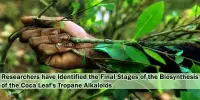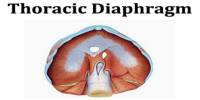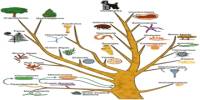Four days after Hurricane Ian made landfall in Florida on October 2, 2022, a search-and-rescue Rottweiler called Ares was roaming the devastated streets of Fort Myers when the opportunity he had been practicing for presented itself. Ares ran upstairs after detecting a scent inside a destroyed house while his handler followed close behind, cautiously navigating the rubble.
When the ceiling of his bathroom collapsed, trapping him within for two days, they discovered him. Over 152 people perished in Ian, one of Florida’s greatest hurricanes, but that fortunate man lived because of Ares’ capacity to locate the source of a scent.
We often take for granted the ability of a dog to find a person buried under rubble, a moth to follow a scent plume to its mate or a mosquito to smell the carbon dioxide you exhale. Yet, using your nose to navigate is trickier than it might seem, and scientists are still trying to figure out how animals accomplish it.
“What makes it hard is that odors, unlike light and sound, don’t travel in a straight line,” says Gautam Reddy, a biological physicist at Harvard University who coauthored a survey of the way animals locate odor sources in the 2022 Annual Review of Condensed Matter Physics.
You can see the problem by looking at a plume of cigarette smoke. Initially it rises and moves in a somewhat straight line, but very quickly it begins to oscillate before beginning to tumble chaotically, a process known as turbulent flow. How could an animal follow such a convoluted route back to its origin?
Through the use of a variety of cutting-edge high-tech instruments over the past two decades, including genetic engineering, virtual reality, and mathematical models, it has been possible to investigate olfactory navigation in fundamentally new ways.
The methods that animals employ and their success rates appear to be influenced by a number of variables, including the animal’s body type, cognitive capacity, and the turbulence of the olfactory plume.
One day, this growing understanding may help scientists develop robots that can accomplish tasks that we now depend on animals for: dogs to search for missing people, pigs to search for truffles and, sometimes, rats to search for land mines.
The problem of tracking an odor seems as if it should have an elementary solution: Simply sniff around and head in the direction where the scent is strongest. Continue until you find the source.
If the odor molecules are dispersed in a well-mixed fog at the end of the diffusion phase, this tactic known as gradient search or chemotaxis functions pretty effectively. However, as diffusion moves very slowly, thorough mixing can take a while. The majority of the time, scents in the environment move through the air as a plume or narrow stream with distinct boundaries.
We noticed that flies, when they encounter an odor plume, would usually turn toward the center line of the plume. Once they find the center line, the source is most likely to be directly upwind. We asked, how the heck does the fly know where the center of the plume is?
Thierry Emonet
Such plumes, and the smells they convey, travel much more quickly than they would by diffusion. In some respects, this is good news for a predator, which can’t afford to wait hours to track its prey.
But the news is not all good: Odor plumes are almost always turbulent, and turbulent flow makes searching by gradient wildly inefficient. It’s possible that the scent’s fastest-growing direction could point away from the source at any one time.
Animals can call on a variety of other strategies. Flying insects, such as moths in search of a mate, adopt a “cast-and-surge” strategy, which is a form of anemotaxis, or response based on air currents. When a male moth detects a female’s pheromones, he will immediately start flying upwind, assuming there is a wind.
If he loses the scent which probably will happen, especially when he is far away from the female he will then start “casting” from side to side in the wind. When he finds the plume again, he will resume flying upwind (the “surge”) and repeat this behavior until he sees the female.
Some land-bound insects may use a strategy called tropotaxis, which could be thought of as smelling in stereo: Compare the strength of the smell at the two antennae and turn toward the antenna getting the strongest signal.
Mammals, which typically have nostrils that are more narrowly spaced relative to body size than an insect’s antennae, often use a comparison-shopping strategy called klinotaxis: Turn your head and sniff on one side, turn your head and sniff on the other side, and turn your body in the direction of the stronger smell. Keeping track of the most recent whiff necessitates a somewhat higher level of cognitive, which is needed in this situation.
Robots that detect odors may be able to use a different tactic that nature may not have thought of. In 2007, physicist Massimo Vergassola of l’École Normale Supérieure in Paris, proposed a strategy called infotaxis, in which olfaction meets the information age.
With infotaxis, in contrast to the majority of other techniques, which are entirely reactive, the navigator builds a mental model of where the source is most likely to be based on the data it has already gathered. Thereafter, it will move in a way that gathers the most details about the smell’s origin.
The robot will either move toward the most likely direction of the source (exploiting its previous knowledge) or toward the direction about which it has the least information (exploring for more information). Its objective is to identify the exploitation and exploration mix that maximizes the anticipated information yield.
Exploration is preferable in the beginning; when the navigator approaches the source, exploitation is a superior option. In simulations, navigators who employ this tactic take routes that closely resemble moth cast-and-surge trajectories.
In Vergassola’s earliest version, the navigator needs to make a mental map of its surroundings and calculate a mathematical quantity called Shannon entropy, a measure of unpredictability that is high in directions the navigator has not explored and low in directions it has explored. This probably requires cognitive abilities that animals do not possess. But Vergassola and others have developed newer versions of infotaxis that are less computationally demanding.
An animal, for example, “can take short cuts, maybe approximate the solution to within 20 percent, which is pretty good,” says Vergassola, a co-author of the Annual Reviews article.
Infotaxis, klinotaxis, tropotaxis, anemotaxis … which taxis will get you to your destination first? One way to figure that out is to go beyond qualitative observations of animal behavior and to program a virtual critter. Researchers can then figure out the success rate of various strategies under a variety of situations in both air and water.
“We can manipulate far more things,” says Bard Ermentrout, a mathematician at the University of Pittsburgh and a member of Odor2Action, a 72-person research group organized by John Crimaldi, a fluid dynamicist at the University of Colorado, Boulder. For instance, researchers can examine how well a fly’s search strategy would function underwater or they can increase the fluid’s turbulence and observe when a specific search approach begins to fail.
So far, simulations show that when turbulence is low, both stereo smelling and comparison shopping work most of the time though, as expected, the former works better for animals with widely spaced sensors (think insects) and the latter works better for animals with closely spaced sensors (think mammals).
For high turbulence, though, a simulated animal doesn’t perform well with either approach. Yet real mice hardly seem fazed by a turbulent plume, lab experiments show. This suggests that mice may still have tricks we don’t know about, or that our description of klinotaxis is too simple.
Furthermore, while simulations can tell you what an animal might do, they don’t necessarily say what it does. And we still don’t have a way to ask the animal, “What is your strategy?” But high-tech experiments with fruit flies are getting closer and closer to that Dr. Dolittle-style dream.
Fruit flies are in many ways ideal organisms for smell research. Their olfactory systems are simple, with only about 50 kinds of receptors (compared to about 400 in humans, and more than 1,000 in mice). Their brains are also relatively simple, and the connections between neurons in their central brain have been mapped: The fruit fly’s connectome, a sort of wiring diagram for its central brain, was published in 2020.
“You can look up any neuron and see whom it’s connected to,” says Katherine Nagel, a neuroscientist at New York University and another of the Odor2Action team members. Before, the brain was a black box; now researchers like Nagel can just look the connections up.
One of the puzzles about flies is that they appear to use a different version of the “surge-and-cast” strategy than moths. “We noticed that flies, when they encounter an odor plume, would usually turn toward the center line of the plume,” says Thierry Emonet, a biophysicist at Yale University. Once they find the center line, the source is most likely to be directly upwind. “We asked, how the heck does the fly know where the center of the plume is?”
Emonet and his collaborator Damon Clark (a physicist whose lab is next door) have answered this question with an ingenious combination of virtual reality and genetically modified flies. In the early 2000s, researchers developed mutant flies with olfactory neurons that respond to light.
“It turns the antenna into a primitive eye, so we can study olfaction the way that we study vision,” says Clark.
This solved one of the biggest problems in smell research: You usually can’t see the odor plume that an animal is responding to. Now you can not only see it, you can project a movie of any odor landscape you want. The genetically modified fly will perceive this virtual reality as a smell and respond to it accordingly. Another mutation rendered the flies blind, so that their actual vision wouldn’t interfere with the visual “odor.”
In their experiments, Clark and Emonet put these genetically modified flies in a container that confines their motion to two dimensions. The researchers next exposed the flies to a moving-stripe visual odor landscape after they had become used to the arena. They discovered that the flies consistently moved toward the approaching stripes.
Next, Clark and Emonet presented a more realistic odor landscape, with turbulent twists and swirls copied from real plumes. The flies were able to navigate successfully to the center of the plume.
Lastly, to conduct an experiment that could not possibly be carried out with a genuine olfactory plume, the researchers projected a time-reversed movie of the exact same plume. This caused the average velocity of the odor in the virtual plume to be toward the center, rather than away. The flies were confused by this bizarro-world plume and moved away from the center rather than toward it.
Flies, Clark and Emonet concluded, must sense the motion of odor packets, as Emonet calls discrete clumps of odor molecules. Think about this for a second: When you smell the neighbor’s barbecue, can you tell whether the smoke particles passing your nose are traveling from left to right, or right to left? It’s not obvious. But a fly can tell and olfaction researchers have previously overlooked this possibility.
How does sensing the motion of odor molecules help the fly find the center of the plume? The important thing to remember is that, at any given moment, more odor molecules are moving away from the plume’s core than toward it.
As Emonet explains, “the number of packets in the center line is higher than away from it. So you get a lot of packets in the center moving away, and not as many from the outside moving in. Each packet individually has equal probability of moving in any direction, but collectively there is a dispersion away from the center.”
In actuality, the flies are processing the incoming sensory data in an incredibly complex manner. The fly moves in a path that is actually a mixture of two different directions in a windy environment: the direction of air flow and the typical motion of odor packets.
By using the fly connectome, Nagel has pinpointed one of the places in the brain where this processing must occur. At a specific location in the fly’s brain known as the “fan-shaped body,” wind-sensing neurons cross across olfactory direction-sensing neurons. Together, the two sets of neurons tell the fly which direction to move in.
In other words, the fly is not just reacting to its sensory inputs but also combining them. Since each set of directions is what mathematicians call a vector, the combination is a vector sum. It’s possible, says Nagel, that the flies are literally adding vectors. If so, their neurons are performing a calculation that human college students learn how to do in vector calculus.
Nagel plans to look next for similar neural structures in the brains of crustaceans. “The odor is completely different, the locomotion is different, but this central complex region is conserved,” she says. “Are they doing fundamentally the same thing as flies?”
There are still a lot of concerns that need to be resolved, even though the connectome and virtual reality trials are yielding some incredible discoveries. How do dogs like Ares track a smell that is partly on the ground and partly in the air? How do they allocate their time between sniffing the ground and sniffing the air? For that matter, how does “sniffing” work? Many animals actively disturb the airflow, rather than just passively receiving it; mice, for example, “whisk” with their whiskers. How do they use this information?
And what other non-human abilities might animals possess, akin to the flies’ ability to detect the motion of an odor packet? Biologists, physicists, and mathematicians will probably continue to seek solutions to these and numerous more riddles for a very long time.
















